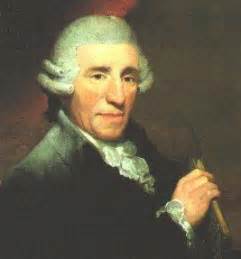Franz Joseph Haydn
(1732-1809)
 A true original, Franz Joseph Haydn is considered the father of the symphony, sonata, and string quartet, making him a revolutionary of the Classical genre. Often experimenting with dynamics and spiking his works with humor and musical trickery, he influenced Wolfgang Amadeus Mozart and future composers such as 20th century satirist Peter Schickele.
A true original, Franz Joseph Haydn is considered the father of the symphony, sonata, and string quartet, making him a revolutionary of the Classical genre. Often experimenting with dynamics and spiking his works with humor and musical trickery, he influenced Wolfgang Amadeus Mozart and future composers such as 20th century satirist Peter Schickele.
The son of a wheelwright and a former cook, Haydn was born in 1732 in the Austrian village of Rohrau, near the Hungarian border. Though the family was not well off and lacked proper musical training, music was a part of their everyday life. His father, Mathias, was a folk musician who taught himself how to sing and play the harp, and by the age of six, young Joseph was able to match his father’s singing with total accuracy. Impossible to find proper musical training in Rohrau, Haydn relocated to Hainburg under the watchful eye of Johann Matthias Franck, a family relative and choirmaster, to pursue his education.
Conditions in Hainburg were harsh. Though he was underfed and not well clothed, Haydn learned both violin and harpsichord, and excelled in the church choir. Singing the demanding treble parts, he was discovered by Georg von Ruetter, and continued his training at St. Stephen’s Cathedral in Vienna. Though composition was not the focus of his studies during his nine years at St. Stephen’s, Haydn taught himself by working through counterpoint exercises by Johann Joseph Fux and studying the works of C.P.E. Bach. By 1749, however, the boy was becoming a man, and after his voice deepened, he was unceremoniously dropped from the St. Stephen’s choir and left, essentially, homeless. Haydn began a period of freelancing, taking on students, working as a street musician, and performing as accompanist for Italian composer Nicola Porpora.
Haydn’s reputation as an emerging composer gained regional attention with the completion of his first string quartets and the comedic opera Der Krumme Teufel (The Limping Devil). Haydn’s fortune improved as he accepted positions with the elite upper crust of Austrian society. Finally, with a reliable income, he was able to marry Maria Anna Aloysia Apollonia Keller in 1760, though the marriage would quickly grow to be an unhappy one. Continuing his upward mobility, Haydn was soon appointed Kapellmeister, or music director, for the wealthy Esterházy family of Eisenstadt. His position lasted nearly thirty years and proved to be fruitful due to the creative freedom and financial security. In addition, he was permitted to accept outside commissions, adding to his massively prolific output and including important works such as The Paris Symphonies and The Seven Last Words of Christ.
With the High Baroque style going out of fashion, Haydn’s early compositions were adventurous and experimental. Greatly influenced by C.P.E. Bach, the composer entered his “Sturm und Drang” phase of the late 1760s and early 1770s, featuring music that contained angular themes and unpredictable melodies. Perhaps the most famous example of Haydn’s wit is the “Surprise” Symphony (Symphony No. 94), written while visiting England. Aside from the musical surprise for the audience, the piece also exemplifies Haydn’s pioneering expansion of the dynamic range introducing such notations as sfz and sfp.
Haydn’s musical genius also brought the “sonata form”, taking a single motif, developing it, and following with a restating of the original theme, which became a standard compositional technique. He developed many other musical innovations, including the integration of the fugue into the classical style of composition, and the introduction of the double variation form, which alternated two, often major and minor, themes. Working in Eisenstadt, away from the musical hotbed of Vienna, was the greatest catalyst of his originality.
Haydn had direct influence over the following generation of composers, serving as a teacher to Ludwig van Beethoven, and as an admirer and friend of Wolfgang Amadeus Mozart. Toward the end of his life, Haydn returned to Vienna and completed two great oratorios, The Creation and The Seasons, as well as other religious works. Gradually, illness left him unable to compose, and in 1809, Haydn died peacefully. Mozart’s Requiem was performed at his memorial service. Haydn’s work was pivotal in the world of music, making him one of the great masters of the Classical period and developer of some of the most standard compositional techniques in music. His forward thinking and imagination echoes throughout the Romantic period, influencing future composers of all genres.
Click below to view Franz Joseph Haydn titles:
t7t3l0uhl8|0010C39D6D07|DetailContent|contenttext|46DF5DF3-4443-4D27-9591-23412B70EF45
<